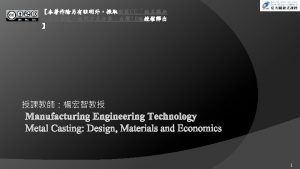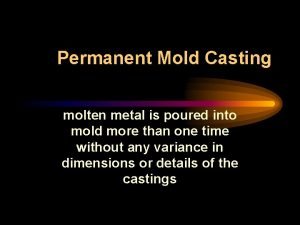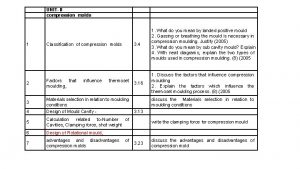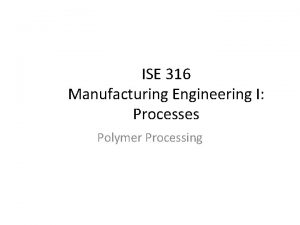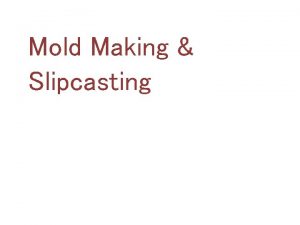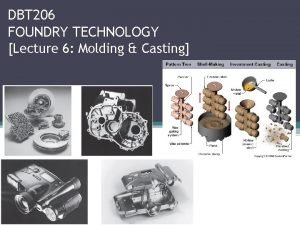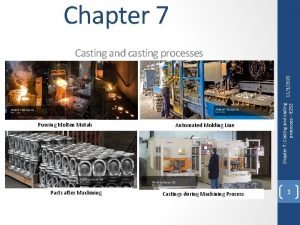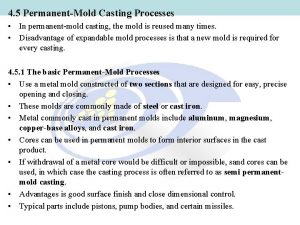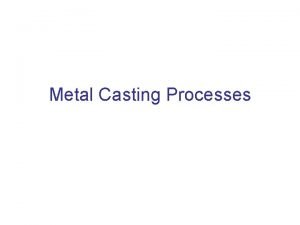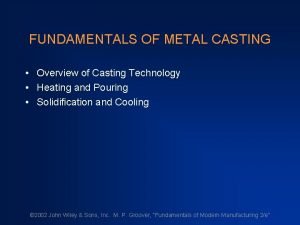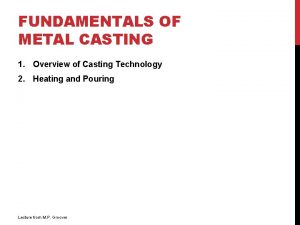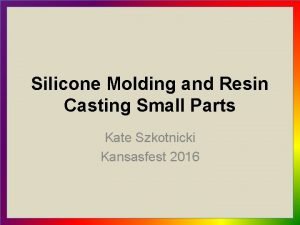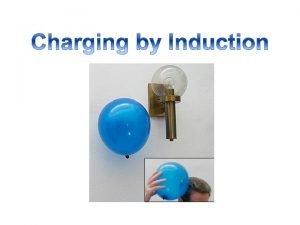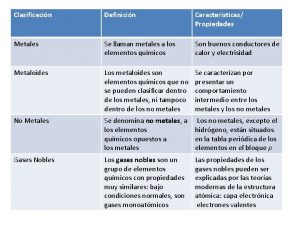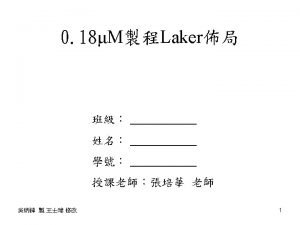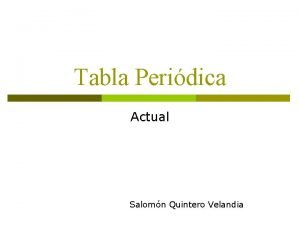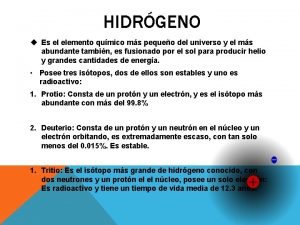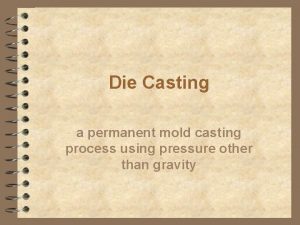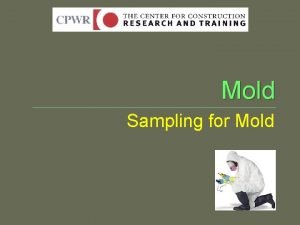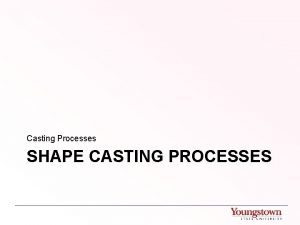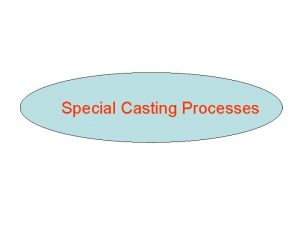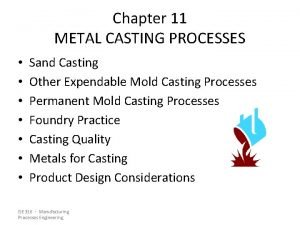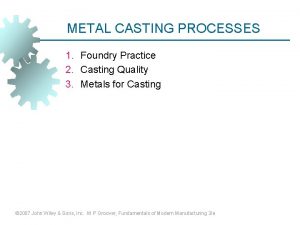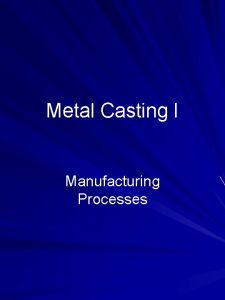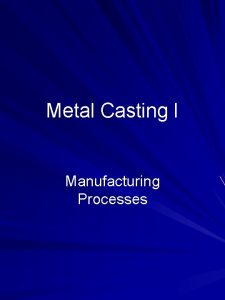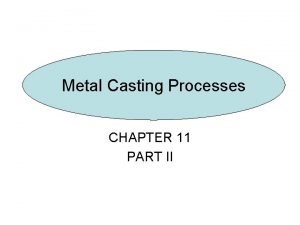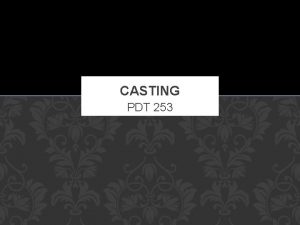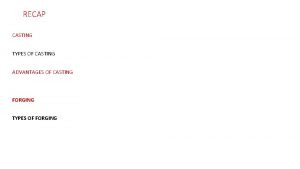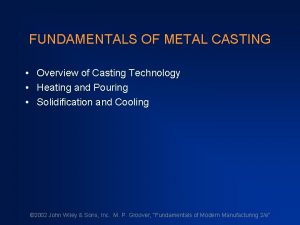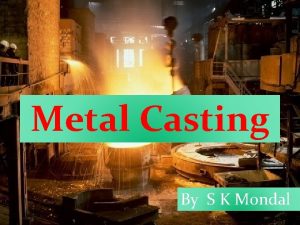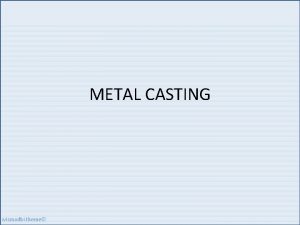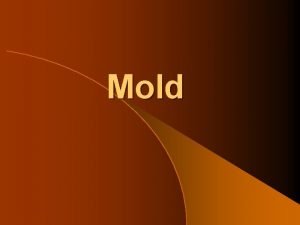METAL CASTING PROCESSES 1 Permanent Mold Casting Processes



























- Slides: 27

METAL CASTING PROCESSES 1. Permanent Mold Casting Processes © 2007 John Wiley & Sons, Inc. M P Groover, Fundamentals of Modern Manufacturing 3/e

Permanent Mold Casting Processes § Economic disadvantage of expendable mold casting: a new mold is required for every casting § In permanent mold casting, the mold is reused many times § The processes include: § Basic permanent mold casting § Die casting § Centrifugal casting © 2007 John Wiley & Sons, Inc. M P Groover, Fundamentals of Modern Manufacturing 3/e

The Basic Permanent Mold Process Uses a metal mold constructed of two sections designed for easy, precise opening and closing § Molds used for casting lower melting point alloys are commonly made of steel or cast iron § Molds used for casting steel must be made of refractory material, due to the very high pouring temperatures © 2007 John Wiley & Sons, Inc. M P Groover, Fundamentals of Modern Manufacturing 3/e

Permanent Mold Casting Figure : Steps in permanent mold casting: (1) mold is preheated and coated © 2007 John Wiley & Sons, Inc. M P Groover, Fundamentals of Modern Manufacturing 3/e

Permanent Mold Casting Figure : Steps in permanent mold casting: (2) cores (if used) are inserted and mold is closed, (3) molten metal is poured into the mold, where it solidifies. © 2007 John Wiley & Sons, Inc. M P Groover, Fundamentals of Modern Manufacturing 3/e

Advantages and Limitations § Advantages of permanent mold casting: § Good dimensional control and surface finish § More rapid solidification caused by the cold metal mold results in a finer grain structure, so castings are stronger § Limitations: § Generally limited to metals of lower melting point § Simpler part geometries compared to sand casting because of need to open the mold § High cost of mold © 2007 John Wiley & Sons, Inc. M P Groover, Fundamentals of Modern Manufacturing 3/e

Applications of Permanent Mold Casting § Due to high mold cost, process is best suited to high volume production and can be automated accordingly § Typical parts: automotive pistons, pump bodies, and certain castings for aircraft and missiles § Metals commonly cast: aluminum, magnesium, copper‑base alloys, and cast iron © 2007 John Wiley & Sons, Inc. M P Groover, Fundamentals of Modern Manufacturing 3/e

Die Casting A permanent mold casting process in which molten metal is injected into mold cavity under high pressure § Pressure is maintained during solidification, then mold is opened and part is removed § Molds in this casting operation are called dies; hence the name die casting § Use of high pressure to force metal into die cavity is what distinguishes this from other permanent mold processes © 2007 John Wiley & Sons, Inc. M P Groover, Fundamentals of Modern Manufacturing 3/e

§ Video © 2007 John Wiley & Sons, Inc. M P Groover, Fundamentals of Modern Manufacturing 3/e

Die Casting Machines § § Designed to hold and accurately close two mold halves and keep them closed while liquid metal is forced into cavity Two main types: 1. Hot‑chamber machine 2. Cold‑chamber machine © 2007 John Wiley & Sons, Inc. M P Groover, Fundamentals of Modern Manufacturing 3/e

Hot-Chamber Die Casting Metal is melted in a container, and a piston injects liquid metal under high pressure into the die § High production rates - 500 parts per hour not uncommon § Applications limited to low melting‑point metals that do not chemically attack plunger and other mechanical components § Casting metals: zinc, tin, lead, and magnesium © 2007 John Wiley & Sons, Inc. M P Groover, Fundamentals of Modern Manufacturing 3/e

Hot-Chamber Die Casting Figure : Cycle in hot‑chamber casting: (1) with die closed and plunger withdrawn, molten metal flows into the chamber © 2007 John Wiley & Sons, Inc. M P Groover, Fundamentals of Modern Manufacturing 3/e

Hot-Chamber Die Casting Figure : Cycle in hot‑chamber casting: (2) plunger forces metal in chamber to flow into die, maintaining pressure during cooling and solidification. © 2007 John Wiley & Sons, Inc. M P Groover, Fundamentals of Modern Manufacturing 3/e

Cold‑Chamber Die Casting Machine Molten metal is poured into unheated chamber from external melting container, and a piston injects metal under high pressure into die cavity § High production but not usually as fast as hot‑chamber machines because of pouring step § Casting metals: aluminum, brass, and magnesium alloys © 2007 John Wiley & Sons, Inc. M P Groover, Fundamentals of Modern Manufacturing 3/e

Cold‑Chamber Die Casting Figure : Cycle in cold‑chamber casting: (1) with die closed and ram withdrawn, molten metal is poured into the chamber © 2007 John Wiley & Sons, Inc. M P Groover, Fundamentals of Modern Manufacturing 3/e

Cold‑Chamber Die Casting ; Figure : Cycle in cold‑chamber casting: (2) ram forces metal to flow into die, maintaining pressure during cooling and solidification. © 2007 John Wiley & Sons, Inc. M P Groover, Fundamentals of Modern Manufacturing 3/e

Molds for Die Casting § Usually made of tool steel, mold steel, or maraging steel § Tungsten and molybdenum (good refractory qualities) used to die cast steel and cast iron § Ejector pins required to remove part from die when it opens § Lubricants must be sprayed into cavities to prevent sticking © 2007 John Wiley & Sons, Inc. M P Groover, Fundamentals of Modern Manufacturing 3/e

Advantages and Limitations § Advantages of die casting: § Economical for large production quantities § Good accuracy and surface finish § Thin sections are possible § Rapid cooling provides small grain size and good strength to casting § Disadvantages: § Generally limited to metals with low metal points § Part geometry must allow removal from die © 2007 John Wiley & Sons, Inc. M P Groover, Fundamentals of Modern Manufacturing 3/e

Centrifugal Casting A family of casting processes in which the mold is rotated at high speed so centrifugal force distributes molten metal to outer regions of die cavity § The group includes: § True centrifugal casting § Semicentrifugal casting § Centrifuge casting © 2007 John Wiley & Sons, Inc. M P Groover, Fundamentals of Modern Manufacturing 3/e

True Centrifugal Casting Molten metal is poured into rotating mold to produce a tubular part § In some operations, mold rotation commences after pouring rather than before § Parts: pipes, tubes, bushings, and rings § Outside shape of casting can be round, octagonal, hexagonal, etc , but inside shape is (theoretically) perfectly round, due to radially symmetric forces © 2007 John Wiley & Sons, Inc. M P Groover, Fundamentals of Modern Manufacturing 3/e

True Centrifugal Casting Figure : Setup for true centrifugal casting. © 2007 John Wiley & Sons, Inc. M P Groover, Fundamentals of Modern Manufacturing 3/e

Analysis for Horizontal centrifugal casting § © 2007 John Wiley & Sons, Inc. M P Groover, Fundamentals of Modern Manufacturing 3/e

Numerical § A true centrifugal casting operation is to be performed horizontally to make copper tube sections with OD = 25 cm and ID = 22. 5 cm. What rotational speed is required if a G-factor of 65 is used to cast the tubing? © 2007 John Wiley & Sons, Inc. M P Groover, Fundamentals of Modern Manufacturing 3/e

Vertical Centrifugal Casting § © 2007 John Wiley & Sons, Inc. M P Groover, Fundamentals of Modern Manufacturing 3/e

Semicentrifugal Casting Centrifugal force is used to produce solid castings rather than tubular parts § Molds are designed with risers at center to supply feed metal § Density of metal in final casting is greater in outer sections than at center of rotation § Often used on parts in which center of casting is machined away, thus eliminating the portion where quality is lowest § Examples: wheels and pulleys © 2007 John Wiley & Sons, Inc. M P Groover, Fundamentals of Modern Manufacturing 3/e

Centrifuge Casting Mold is designed with part cavities located away from axis of rotation, so that molten metal poured into mold is distributed to these cavities by centrifugal force § Used for smaller parts § Radial symmetry of part is not required as in other centrifugal casting methods © 2007 John Wiley & Sons, Inc. M P Groover, Fundamentals of Modern Manufacturing 3/e

© 2007 John Wiley & Sons, Inc. M P Groover, Fundamentals of Modern Manufacturing 3/e
 Permanent mold casting
Permanent mold casting Slip casting advantages and disadvantages
Slip casting advantages and disadvantages Expendable mold casting advantages and disadvantages
Expendable mold casting advantages and disadvantages Graphite permanent mold casting
Graphite permanent mold casting Protista unicellular or multicellular
Protista unicellular or multicellular Pot type transfer moulding diagram
Pot type transfer moulding diagram Pot type mold & plunger type mold are the classification of
Pot type mold & plunger type mold are the classification of How to make slip casting molds
How to make slip casting molds Expendable pattern casting
Expendable pattern casting Sand mold casting
Sand mold casting Liquid metal
Liquid metal Metal casting
Metal casting Fundamentals of casting
Fundamentals of casting Fundamentals of metal casting
Fundamentals of metal casting Casting small parts
Casting small parts Is charging by induction temporary or permanent
Is charging by induction temporary or permanent Properties of semimetals
Properties of semimetals Oxigeno caracteristicas y propiedades
Oxigeno caracteristicas y propiedades Melting point of nonmetals
Melting point of nonmetals When a metal reacts with a nonmetal the metal will
When a metal reacts with a nonmetal the metal will Venn diagram about solid liquid and gas
Venn diagram about solid liquid and gas Example of metal elements
Example of metal elements Nwell
Nwell P
P Compare metals nonmetals and metalloids
Compare metals nonmetals and metalloids Hidrgeno
Hidrgeno Metals are used
Metals are used Chemical bond def
Chemical bond def
